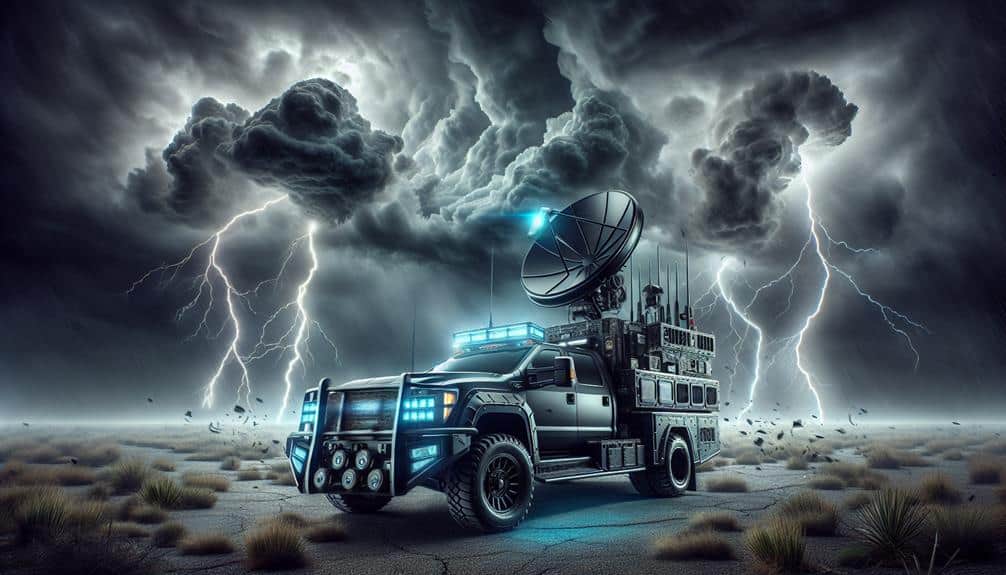We've identified three key advantages of Doppler radar in hurricane tracking: real-time data accuracy, enhanced storm prediction, and improved safety measures. Doppler radar allows us to track storms with high precision by analyzing precipitation particles and measuring signal phase shifts. This technology greatly enhances our prediction models by accurately tracking wind speeds and rotational patterns. Additionally, the real-time data on storm intensity and trajectory facilitates better resource allocation and evacuation planning. These advancements result in more effective emergency response protocols and heightened safety during hurricanes. By exploring further, you'll uncover more insights into these critical benefits.
Key Points
- Doppler radar provides precise tracking of hurricane paths and intensity.
- Real-time data on wind speeds helps predict hurricane development and trajectory.
- Analysis of rotational patterns aids in early detection of hurricane formation.
- Accurate rainfall rate measurements help anticipate and mitigate flooding risks.
Real-Time Data Accuracy
Doppler radar provides highly accurate real-time data that allows meteorologists to track hurricanes with greater precision and predictability. By analyzing the velocity and movement of precipitation particles, we can pinpoint the exact location and intensity of a storm. This precise forecasting is a direct result of significant meteorological advancements. Doppler radar systems measure the phase shift in returned radar signals, translating that into detailed insights about storm dynamics.
With this technology, our ability to monitor changes in a hurricane's path and intensity has dramatically improved. Real-time data accuracy empowers us to make informed decisions swiftly, leading to rapid response initiatives. Emergency preparedness relies heavily on such timely and precise information.
When we've accurate data, we can better advise evacuation orders, resource allocation, and other critical actions that protect lives and property.
In this context, Doppler radar's contribution to meteorology can't be overstated. It enhances our capacity to respond to natural disasters efficiently, ensuring we can uphold the freedom and safety of affected communities. By leveraging these technological breakthroughs, we're setting new standards in hurricane tracking and emergency management.
Enhanced Storm Prediction
By leveraging Doppler radar data, we notably enhance our storm prediction models, enabling more accurate forecasts of hurricane trajectories and intensities. This advancement is pivotal for precise location tracking and enhanced forecasting capabilities, providing critical data that can help us make informed decisions.
Using Doppler radar, we can:
- Track Wind Speeds: Doppler radar measures wind speeds within a storm, allowing us to determine its intensity and potential for escalation.
- Identify Storm Rotation: By detecting rotational patterns, we can better predict the formation and path of hurricanes.
- Monitor Precipitation: Enhanced data on rainfall rates and distribution helps us anticipate flooding and other storm-related impacts.
- Analyze Storm Structure: Detailed images of a storm's internal structure aid in understanding its development and potential changes.
These capabilities notably improve our predictive models. Precise location tracking allows us to monitor storms with unparalleled accuracy, ensuring that our forecasts are timely and reliable. Enhanced forecasting capabilities mean that we can predict not only where a storm will go but also how strong it will be when it gets there.
This empowers us to provide more accurate warnings and allocate resources more effectively, ultimately enhancing our ability to manage and mitigate hurricane impacts.
Improved Safety Measures
With enhanced forecasting capabilities, we can now implement improved safety measures that directly protect lives and property during hurricanes. Doppler radar technology provides us with real-time data on storm intensity, trajectory, and potential landfall zones, enabling more accurate emergency response. By analyzing this precise information, emergency management teams can allocate resources more effectively and reduce response times, which is vital for preserving both freedom and safety.
Our ability to predict storm surges and high-risk areas means that evacuation routes can be planned with greater accuracy. We can designate specific zones for evacuation earlier, minimizing congestion and ensuring smoother, swifter evacuations. This proactive approach not only saves lives but also empowers communities to act decisively and independently.
Moreover, the integration of Doppler radar data into emergency response protocols enhances coordination between federal, state, and local agencies. This streamlined communication ensures that critical information reaches those in need without delay. By leveraging Doppler radar's advantages, we can foster a culture of preparedness and resilience, granting individuals the freedom to make informed decisions during hurricane events.
Through these data-driven strategies, we're safeguarding our communities and enhancing our ability to face natural disasters head-on.
Frequently Asked Questions
How Does Doppler Radar Technology Work?
We might think Doppler radar principles are complex, but they're actually fascinating. By measuring the frequency shift of returned radar signals, we can perform an accuracy assessment of wind speeds and precipitation, providing essential data for weather forecasting.
Are There Limitations to Using Doppler Radar for Hurricane Tracking?
Yes, there are limitations when using Doppler radar for hurricane tracking. While Doppler radar provides high accuracy, data interpretation can be complex, and the technology may struggle with certain atmospheric conditions, affecting overall reliability in some scenarios.
What Are the Costs Associated With Installing and Maintaining Doppler Radar Systems?
When considering the costs, we need to evaluate both installation and ongoing maintenance expenses. Despite high costs, the benefits of enhanced accuracy in tracking hurricanes justify the investment, ensuring timely, precise data for best freedom and safety.
How Has Doppler Radar Technology Evolved Over the Years?
Doppler radar evolution has been a game-changer; it's revolutionized weather forecasting and applications. We've seen enhanced accuracy and resolution. Future innovations promise even greater advancements, empowering us with the freedom to make informed decisions in unpredictable weather.
Can Doppler Radar Be Combined With Other Technologies for Better Hurricane Tracking?
We can combine Doppler radar with satellite communication integration for enhanced hurricane tracking. This allows real-time data integration, providing more accurate forecasts. This synergy offers unprecedented precision, empowering us to make informed decisions and protect lives and property effectively.


